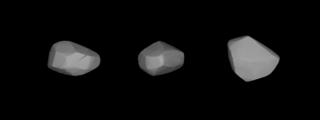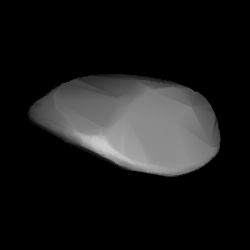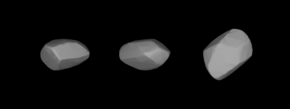
5 Astraea is an asteroid in the asteroid belt. This object is orbiting the Sun at a distance of 385 million kilometres (2.5735 AU) with a period of 4.13 yr and an orbital eccentricity of 0.19. The orbital plane is inclined at an angle of 5.37° to the plane of the ecliptic. It is spinning with a period of 16.8 h. The surface of Astraea is highly reflective and its composition is probably a mixture of nickel–iron with silicates of magnesium and iron. It is an S-type asteroid in the Tholen classification system.

64 Angelina is an asteroid from the central region of the asteroid belt, approximately 50 kilometers in diameter. It is an unusually bright form of E-type asteroid.

95 Arethusa is a large main-belt asteroid. It was discovered by German astronomer Robert Luther on 23 November 1867, and named after one of the various Arethusas in Greek mythology. Arethusa has been observed occulting a star three times: first on 2 February 1998, and twice in January 2003.

125 Liberatrix is a main-belt asteroid. It has a relatively reflective surface and an M-type spectrum. Liberatrix is a member of an asteroid family bearing its own name.

186 Celuta is a 50 km Main belt asteroid. It was discovered by the French astronomers Paul Henry and Prosper Henry on April 6, 1878. This was the last discovery credited to the Prosper brothers. It is classified as an S-type asteroid.

276 Adelheid is a dark Alauda asteroid from the outer region of the asteroid belt, approximately 121 kilometers in diameter. It was discovered by Austrian astronomer Johann Palisa at Vienna Observatory on 17 April 1888. The meaning of the asteroids's name is unknown.

375 Ursula, provisional designation 1893 AL, is a dark asteroid and parent body of the Ursula family from the outer regions of the asteroid belt. It is one of the largest asteroids with a diameter of approximately 200 kilometers. It was discovered on 18 September 1893, by French astronomer Auguste Charlois at Nice Observatory in France. The referent of the asteroids's name is unknown.
449 Hamburga is a carbonaceous asteroid from the background population of the intermediate asteroid belt, approximately 75 kilometers in diameter. It was discovered by German astronomers Max Wolf and Friedrich Schwassmann at Heidelberg Observatory on 31 October 1899, and later named after the city of Hamburg in Germany.

1030 Vitja, provisional designation 1924 RQ, is a dark background asteroid from the outer regions of the asteroid belt, approximately 60 kilometers in diameter. It was discovered on 25 May 1924, by Soviet–Russian astronomer Vladimir Albitsky at the Simeiz Observatory on the Crimean peninsula. The asteroid was named in honor of Viktor Zaslavskij (1925–1944), a relative of the discoverer.

1568 Aisleen, provisional designation 1946 QB, is a stony Phocaea asteroid from the inner regions of the asteroid belt, approximately 12.5 kilometers in diameter. It was discovered on 21 August 1946, by South African astronomer Ernest Johnson at Johannesburg Observatory in South Africa. It is named for the discoverer's wife, Aisleen Johnson.
3960 Chaliubieju, provisional designation 1955 BG, is a stony asteroid from the central regions of the asteroid belt, approximately 9 kilometers in diameter. It was discovered on 20 January 1955, by astronomers at the Purple Mountain Observatory in Nanjing, China. The asteroid was named after Cha Liubieju, a friend of one of the discoverers.
2012 Guo Shou-Jing, provisional designation 1964 TE2, is a carbonaceous asteroid and Florian interloper from the inner regions of the asteroid belt, approximately 13 kilometers in diameter. It was discovered on 9 October 1964, by astronomers at the Purple Mountain Observatory in Nanking, China. The asteroid was named after Chinese astronomer Guo Shoujing.
1325 Inanda, provisional designation 1934 NR, is a stony background asteroid from the central regions of the asteroid belt, approximately 11 kilometers in diameter. It was discovered on 14 July 1934, by South African astronomer Cyril Jackson at the Union Observatory in Johannesburg. The asteroid was named after the township of Inanda in South Africa.
1409 Isko, provisional designation 1937 AK, is a carbonaceous background asteroid from the central regions of the asteroid belt, approximately 35 kilometers in diameter. It was discovered on 8 January 1937, by astronomer Karl Reinmuth at the Heidelberg-Königstuhl State Observatory in southwest Germany. The asteroid was named after Ise Koch, wife of astronomer Fritz Kubach.
1524 Joensuu, provisional designation 1939 SB, is a carbonaceous asteroid from the outer region of the asteroid belt, approximately 42 kilometers in diameter. It was discovered on 18 September 1939, by Finnish astronomer Yrjö Väisälä at Turku Observatory in Southwest Finland, and named for the town of Joensuu.
1574 Meyer, provisional designation 1949 FD, is a carbonaceous asteroid from the outer region of the asteroid belt, approximately 59 kilometers in diameter. It was discovered on 22 March 1949, by French astronomer Louis Boyer at Algiers Observatory in Algeria, northern Africa. It was named after French astronomer M. Georges Meyer.
1429 Pemba, provisional designation 1937 NH, is a stony background asteroid from the central regions of the asteroid belt, approximately 10 kilometers in diameter. It was discovered on 2 July 1937, by South African astronomer Cyril Jackson at the Union Observatory in Johannesburg. The asteroid was named for the Pemba Island off the coast of Tanzania.
1585 Union, provisional designation 1947 RG, is a dark background asteroid from the outer regions of the asteroid belt, approximately 52 kilometers in diameter. It was discovered on 7 September 1947, by South African astronomer Ernest Johnson at the Union Observatory in Johannesburg, South Africa. The asteroid was named after the discovering observatory.

1263 Varsavia, provisional designation 1933 FF, is an asteroid from the central region of the asteroid belt, approximately 40 kilometers in diameter. It was discovered on 23 March 1933, by Belgian astronomer Sylvain Arend at Uccle Observatory in Belgium. It is named for the city of Warsaw.

1545 Thernöe is an elongated background asteroid from the central region of the asteroid belt. It was discovered on 15 October 1941, by Finnish astronomer Liisi Oterma at Turku Observatory in Southwest Finland. The uncommon K-type asteroid has a rotation period of 16.1 hours and measures approximately 18 kilometers in diameter. It was later named after Danish astronomer Karl August Thernöe.











